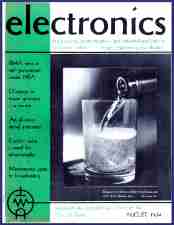Toronto. Movies and Electronics (not the typical science fiction variety movie) came together in the 1930s to extend human understanding. The 1930s were an exciting time (aside from the devastating depression) in photography and in electronics, The minicam revolution gained traction, German camera manufacture was at its best, radio sets and radio networks thrived, colour photography continued to evolve, the electronics industry was booming with new discoveries rampant, and Edgerton was at his best with strobes, but it took a nasty war at the end of the decade to move the world ahead.
Electronics magazine for 1934 (June and August issues) reported exiting news regarding 16mm film and electronics. For home movies, it was advances in on-film sound, and colour film matching the 35mm colour film used for Hollywood extravaganzas.
The application of high speed and electronic control to industrial and scientific movies sparked a greater understanding of motions too brief for the unaided human eye to see. Electronic circuits allowed each frame to be synchronized with a strobe light flashing at about 1 millionth of a second per frame.
Once you overcame the struggle imposed by the depression, it was an exciting time indeed according to my late father. Thanks are due to good friend and fellow photographic historian George Dunbar for sharing this find with me.
NB. the lower left of the magazine cover shows the schematic symbol for a triode vacuum tube. Current flows between the plate (upside down capital T which is positive) and the filament *upside down V which is negative). A low voltage high current battery between the sides of the V make the filament glow bright red and boils off electrons. The squiggly horizontal line is the grid. A very low current and voltage between grid and filament controls the flow of electrons between the filament and plate. This amplifies any alternating current signal. Solid state devices put an end to these archaic components of a by-gone era.









